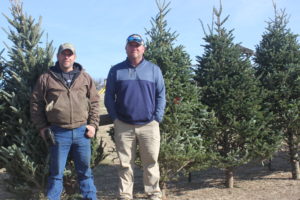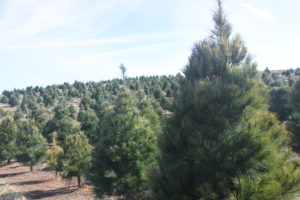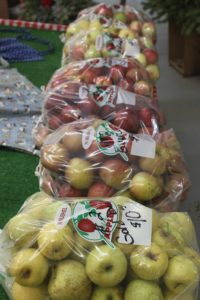
The Schweizer family, including sons Nick and Cory, manage a diverse farming operation in northwest Missouri.
By Dana Rogge, USDA
Meet the Schweizer family of northwest Missouri. The Friday after Thanksgiving kicks off the holiday shopping season, and for the Schweizers, it’s opening day for Christmas tree season on the farm.
Business Evolution
The Schweizer’s farm has been in continuous operation since the early 1900s. Today, Steve and Becky Schweizer, along with their sons, Cory and Nick and their families, operate a diverse farming operation that includes traditional row-crops of corn and soybeans, as well as apples, peaches, and various other seasonal fruits and vegetables.
“We started out doing more traditional stuff – soybeans, corn, and apples,” Cory said. “We got this retail market 20-plus years ago and started selling some vegetables here along with our peaches and apples that we grew, or you picked. We started getting bigger and bigger into it.”
Then they were approached by a large grocery store chain to be a part of their “Homegrown” program that sources fruits and vegetables locally from Midwest farmers. The Schweizers wholesale a host of products, including apples and sweet corn, to the chain’s stores throughout Kansas City and through the chain’s corporate headquarters.

Customers visit the Schweizer farm for Christmas trees starting the day after Thanksgiving through mid-December.
As if that didn’t keep them busy enough, the Schweizers welcome visitors to their farm in St. Joseph, Missouri, starting in the spring with u-pick strawberries, moving to apples and peaches then pumpkins in the fall, and topping off their season with Christmas trees.
Time to Grow
The Schweizers grow an assortment of Christmas trees, including Scotch pines, white pines, and a couple of varieties of firs. Around the first of the year, they plant replacement trees where others have been harvested. Throughout the year, there’s maintenance and upkeep with mowing, weed, and insect control. They tend the trees until they are a marketable height, generally between seven and eight feet tall.
“On a pine, that’s a good seven or eight years. On a fir, that could be up to 14 years before it’s a marketable tree,” Cory said.
And that’s on a good year. Last year, drought conditions set them back, delaying growth.
“We lost a whole year,” Nick said.
This year, they had plenty of moisture, but scorching excessive heat took a toll on their trees.
“You get all kinds of things happening to you weather-wise that determine what that tree’s going to look like now and in the future,” Cory said.
Protect and Recover
Taking care of their resources is innate to the Schweizers. In any given year, they can sell up to 1000 trees. No part of the tree goes to waste. Trimmings and scraps are made into fresh wreaths, swags, grave mounds, or bundled for customers to take home and decorate with fresh greenery.
To protect the natural resources on their farm, they work with USDA’s Natural Resources Conservation Service. Through the Conservation Stewardship Program the Schweizers have installed filter strips and promote precise nutrient management on their crops.

FSA’s Tree Assistance Program helped the Schweizers recover from apple tree losses.
When fire blight, a bacterial disease, hit their apple tree crop, the Schweizers turned to the Tree Assistance Program from USDA’s Farm Service Agency to recover from the destruction. The program provides financial assistance to orchardists and nursery tree growers to replant or rehabilitate eligible trees, bushes, and vines damaged by natural disasters.
The Schweizers also utilize FSA’s Agriculture Risk Coverage and Price Loss Coverage program as a safety net to protect against potential market downturns on their corn and soybean crops.
Growing Trend
During the fall and Christmas tree season, the Schweizers will host 60 to 70 school tours. Students get the opportunity to pick pumpkins or apples and learn about what goes into growing the foods they eat.
Cory describes a big part of their business as “agritainment.”

Families visiting the tree farm can choose from pre-cut options or saw their own perfect pick.
“We do so much entertainment farming,” he said. “I think that is a growing trend. People like to bring their families out.”
Families visiting their tree farm can choose from several pre-cut options, or take a hay ride out to the field where they can saw their own perfect pick.
“It’s a complete different attitude of people this time of year,” Cory said. “This being Christmas, everyone is, nine times out of 10, bubbly and happy and having fun.”
More Information
USDA offers a variety of risk management, disaster assistance, loan, and conservation programs to help agricultural producers in the United States weather ups and downs in the market and recover from natural disasters as well as invest in improvements to their operations. Learn about additional programs.
For more information about USDA programs and services, contact your local USDA service center.
For an interactive version of this story, visit #FridaysOnTheFarm.





